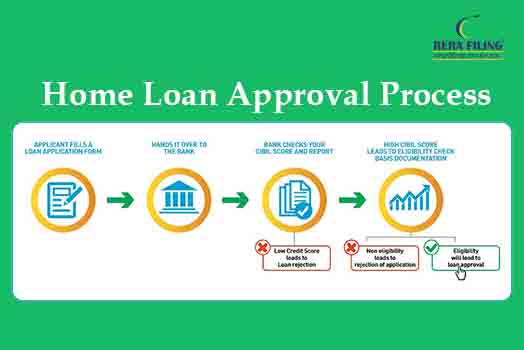Home Loan Approval Process

- Thursday 9th May 2019
- Author: Shreya Uppal
Highlights
Few years back, it was a hard nut to crack to obtain a home loan approval.
before taking a home loan one must compare all the best possible options available in the market and make choice wisely.
The applicant has to ensure that he has submitted genuine documents and any fake document is a criminal offense which can lead to bigger troubles.
Buying a home is a big step. It is a source of anxiety, frustration and one of the biggest liabilities for an individual. With the zooming property rates, it is difficult to buy a home entirely through savings. Therefore, before taking a home loan one must compare all the best possible options available in the market and make choice wisely.
Few years back, it was a hard nut to crack to obtain a home loan approval. Now, with all the technological advancements and online procedures, it has become hassle-free and therefore applying for home loan can be done through a click of the mouse.
Although the procedure of taking a home loan differs from bank to bank in India, but the general procedure remains the same.
Steps to complete the home loan process:
1. Fill the loan application form with relevant documents
Taking a home loan begins with an application form. Some of the basic information about the applicant asked in the form includes:
(a) The personal details of the applicant ( Name, phone no., etc.)
(b) The residential address of the applicant
(c) The monthly or yearly income of the applicant
(d) The property details on which the loan is applied
(e) The estimated cost of the property
(f) The present means of financing the home property
(g) Documents which are required to be attached with the application form include Applicant’s income proof, Applicant’s identity (or ID) proof, Applicant’s address proof, and Applicant’s bank statements.
2. Pay the processing fee
After the completion of 1st step, the next step is to pay the processing fee to the bank for maintaining the applicant’s loan account. The processing fee of a bank usually ranges from 0.25% to 0.50% of the requested loan amount. A commission is then generated by the bank to the agent handling the applicant’s home loan process, which to an extent is taken from the processing fee paid by the applicant.
3. Validation of the documents
Once the applicant has completed step1 and step2, then comes the validation process of above 2 steps where the bank verifies the originality of the documents submitted and there might be cases where an individual has to visit the bank for face to face discussion with the bank so that bank get assurance that the applicant will be able to repay the loan amount with the interest. The applicant has to ensure that he has submitted genuine documents and any fake document is a criminal offense which can lead to bigger troubles.
Note: A bank representative pays a visit to the applicant’s residence or workplace to verify his/her details. At times, the references listed by the applicant in the form are also checked. This enables a clear trust between both the parties
4. The Sanction Process
It is the most crucial stage of a home loan process. This can either have a fruitful result or can be disastrous for an individual.
A bank usually deep-checks the applicant’s following documents to approve loan:
(a) The qualification, age and experience details
(b) The transactions made with the applicant’s bank.
(c) The monthly and yearly income
(d) The current employer and the type of job he pursues
(e) The nature of business (in case of self-employed)
(f) The ability to repay the loan amount with set rate of interest.
Based on the information mentioned above, the bank finalizes and communicates the maximum loan amount the applicant can receive. Finally, this proceeds with an official sanction letter. It can be either unconditional or can contain a few policies, which has to be fulfilled by the applicant before the disbursal.
5. Processing of Offer Letter
If the loan is sanctioned, the bank then sends a certified offer letter stating the below mentioned details:
1. The loan amount that is being sanctioned.
2. The interest rate on the loan amount.
3. Whether the interest rate is variable or fixed.
4. The loan’s tenure details
5. Acceptable mode of loan repayments
6. Other applicable terms and conditions
Once the applicant accept the offer letter and signs the duplicate copy of the offer letter, the next step is then proceeded.
6. Legal Check of the Property papers
(a) Once the property is selected by the applicant which he intends to purchase, the applicant has to submit all the original property documents to the bank which remains with the bank as a security towards the home loan until the home loan is repaid.
(b)The original property papers generally include the name of the seller, name of the property, address of the property, identification and address proof of the seller and NOC (No Objection Certificate) from the Statutory Development Board Representative and Co-operative Housing Society.
(c) Once the property papers are submitted, the bank then validates them for authentication. This process is termed as “legal check.” In fact, the sale papers between the applicant and the seller are verified.
(d) These original documents are sent to the bank’s lawyer for an in-depth check. Only when the lawyer approves all the submitted documents as clear, then everything related to home loan is good.
7. Technical Check and Site Estimation
(a)The bank sends a property expert to check the premises an applicant intends to buy. The visit to the “site property” is basically conducted for verifying the detail like quality of the construction, work progression, the layout of the house and whether the governing authority has permitted it or not.
(b) Once the expert completes the technical inspection of the site, it is then followed by determining and checking the property’s overall value. This is basically done because of the increasing malpractices.There have been multiple cases where the applicants have shown property purchases from the associated entities at extremely inflated rates just to acquire cheap loans.
(c) However, a site’s estimation can help the bank to determine the total loan amount so that the sanction is straightforward.
8. The Loan Disbursal
(a) After technical and site estimation, the lawyer clears all the paperwork and then finalizes all the documents and get them stamped as well as signed.
(b) The applicant then has to sign the loan agreement and submit the post dated cheques for the duration on which both the parties have agreed upon.
(c) After this, the original property papers have to be handed to the bank. Some banks can even create a video recording of the applicant handing over these papers to the bank. This is for the bank’s security, safety, and proof.
(d) This stage is known as the MOE (Memorandum of Execution) and has a stamp duty based on the state the applicant applies at.
(e) Once the applicant signs the papers and everything is legally clear, the loan amount is given via cheque. The cheque is always under either the seller or development/society authority or builder.
More Articles
- Online Listing Tips for Real Estate Agents
- How to start a Real Estate business in India - a complete guide !
- Renting Vs Buying property - How will you decide?
- What you should do in Property Management services
- Home Loan Insurance
- How to choose your builder?
- How to ensure fire safety in your home!
- Tips To Keep In Mind While Taking A Home On Rent
- Importance of Home Security
- How to plan your property budget?
- Leased vs. Purchased vs. Co-Working Office Spaces
- Easy Tips to Build an Eco Friendly Home
- Sample Flat - A Trick by a Builder?
- How to have a Beautiful Guest Room? Impress your Guests with these Guest Room Ideas..
- Understanding MCLR and its Effects on Home Loans
- 5 simple ways to close a real estate deal
- Is it worth to buy property near an airport ?
- Home loan tax benefit
- How to be successful in business as an introvert
- Cost effective home decor ideas
- What to Be-Paying Guest or a Tenant??
- Complete guide to start your small business
- Sports township- New trend in India
- Online Listing Tips for Real Estate Agents
- Understanding Floor Area Ratio- FAR
- Town and Country Planning | Meaning and Importance
- Checklist of Important Property Documents- All You Need to Know
- Role of CREDAI in real estate
Copyright © 2023 RERA Filing. All rights reserved.
 Rera
Act
Rera
Act
 Maharashtra
Maharashtra Karnataka
Karnataka Andhra Pradesh
Andhra Pradesh Uttar Pradesh
Uttar Pradesh